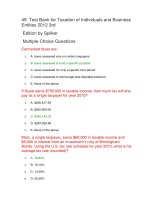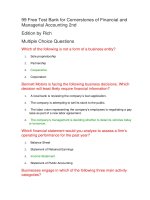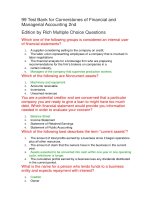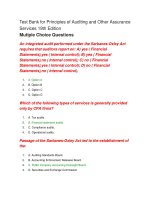Test bank CH02 perception of self and others
Bạn đang xem bản rút gọn của tài liệu. Xem và tải ngay bản đầy đủ của tài liệu tại đây (142.21 KB, 7 trang )
Chapter 2: Perception of Self and Others
MULTIPLE CHOICE
1. The three stages of the perception process are _______.
A. action and selection, expectation of stimuli, and impression
B. attention and selection, organization of stimuli, and impression
C. attention and selection, organization of stimuli, and interpretation
D. action and selection, expectation of stimuli, and interpretation
ANS: C
PTS: 1
2. Failure to recognize a misspelling in a word used in a newspaper illustrates perception that is limited
because of ______.
A. interest
B. need
C. expectations
D. all of the above
ANS: C
PTS: 1
3. Layla and Luke are twins in the U.S. Even though they grew up in the same family at the same time,
Layla grows up thinking that being successful depends a lot on being pretty and nice, while Luke
believes being successful means making a lot of money and being independent. These differences are
likely the result of _______.
A. gendered cultural expectations
B. Layla’s low self-esteem
C. Luke’s effective message filtering
D. different self-talk
ANS: A
PTS: 1
4. As they were walking to the corner store, Samantha and Meagan passed by a large bush. Suddenly,
from out of nowhere, a large dog lunged at them. Meagan gasped and dropped her books, but
Samantha laughed and said, “Oh, that dumb dog always hides behind that bush.” Samantha’s reaction
was a good example of which step of the perception process?
A. patterns
B. interpretation
C. organization
D. expectation
ANS: D
PTS: 1
5. Tonya believes that she is not good at sports, so much so that when she takes part in athletic activities
she is timid and performs poorly, and usually finds a way to sideline herself from the game. This is an
example of _______.
A. stereotype
B. self-fulfilling prophecy
C. role
D. halo effect
ANS: B
PTS: 1
6. According to your text, the self-concept can best be defined as _______.
A.
B.
C.
D.
a pattern of behavior that characterizes a person’s place in a context
a mental image a person has about his or her skills, abilities, and knowledge
a set of assumptions developed about physical characteristics and popularity
a combination of your original ideas and theories about life
ANS: B
PTS: 1
7. Amy was traumatized as a child when she had a bad experience jumping from a diving board. To this
day, she considers herself a poor swimmer. That experience as a child has affected her.
A. self-perception
B. self-monitoring
C. self-esteem
D. role
ANS: A
PTS: 1
8. Deon and Janet, who do not know each other, are assigned to work on a project together at work.
Deon suggests that the two have a lunch meeting together to get to know one another before beginning
the official work. Deon’s suggestion is an effort to _______.
A. evaluate an implicit personality theory
B. use stereotypes
C. make attributions
D. reduce uncertainty
ANS: D
PTS: 1
9. According to the text, our “evaluation of competence and worthiness” defines _______.
A. self-esteem
B. self-concept
C. self-attribution
D. self-consideration
ANS: A
PTS: 1
10. You find your roommate Marcus singing to himself in the kitchen, and you are impressed. “Man,
Marcus, you’ve got a great voice!” Marcus looks embarrassed. “No way, you don’t need to try to make
me feel better. I know I’m terrible. I’ve never been able to sing.” And no matter how hard you try to
convince him otherwise, Marcus continues to feel worse about his singing ability. This gap between
different perceptions is known as _______.
A. implicit personality adjustment
B. incongruence
C. scripted differences
D. behavioral adjustment
ANS: B
PTS: 1
11. Individuals with low self-esteem _______.
A. are more attentive to situations than people with high self-esteem
B. find it easier to dwell on criticism than accept praise
C. cannot gain higher self-esteem, even with practice
D. are unlikely to have self-fulfilling prophecies
ANS: B
PTS: 1
12. Lila and Sherin are sitting in their dorm room while Sherin flips through her notes. “I’m totally going
to fail this math test tomorrow,” Sherin says. The next day, Sherin takes her test and learns that she
failed it. Her performance on the test is an example of _______.
A. incongruence
B. filtering messages
C. halo effect
D. self-fulfilling prophecy
ANS: D
PTS: 1
13. After your first speech, four people tell you that you did a good job, and one tells you that you looked
nervous. If you focus on the comment from the person who told you that you looked nervous and
ignore the positive comments from others, this is called _______.
A. perceptual defense
B. filtering messages
C. halo effect
D. self-fulfilling prophecy
ANS: B
PTS: 1
14. According to your text, what three things affect what we select to pay attention to?
A. needs, interests, and expectations
B. interests, expectations, and values
C. values, beliefs, and stereotypes
D. needs, values, and expectations
ANS: A
PTS: 1
15. Racism, ethnocentrism, sexism, heterosexism, ageism, and able-ism are examples of ______.
A. discrimination
B. attributions
C. prejudice
D. assumed similarity
ANS: C
PTS: 1
16. Imagine that you are saying these messages to yourself: “Oh, I have that interpersonal test in the
morning. I really haven’t studied, so maybe I’ll skip it. But maybe I won’t be able to take a make-up
test. I’d better go after all and take my chances.” This is an example of which self-perceptions?
A. filters others’ statements
B. moderate self-talk
C. predicts behavior
D. influences tone of voice
ANS: B
PTS: 1
17. Jared wants to be a professional singer/songwriter. He performs at open-mike nights, competes in
karaoke competitions, and spends the majority of his free time writing and rehearsing. Jared is
responding to his ______.
A. self-esteem
B. self-perception
C. ideal self-concept
D. self-talk
ANS: C
PTS: 1
18. People from collectivist cultures tend to have higher self-esteem when they view themselves as being
_______.
A. interdependent
B. unique
C. independent
D. self-sufficiency
ANS: A
PTS: 1
19. When we encounter people for the first time, we often try to gain more information about them to help
make ourselves feel more comfortable. This process is called _______.
A. implicit personality theories
B. halo effects
C. discrimination
D. uncertainty reduction
ANS: D
PTS: 1
20. Most people only reveal parts of our self-perceptions depending on what we deem appropriate to the
situation. This phenomenon is called ________.
A. incongruence
B. self-talk
C. discrimination
D. social construction
ANS: D
PTS: 1
21. Because Dawson is a muscular, attractive male, Emily perceives him as being popular, an average
student, and a superb athlete. This best exemplifies the idea of _______.
A. stereotyping
B. implicit personality theories
C. self-esteem
D. attributions
ANS: B
PTS: 1
22. Mary, who always gets good grades on her speeches, writes a paper for the same class. Even though
her paper is mediocre, her teacher gives her an A. This grade may be best explained by the concept of
_______.
A. halo effect
B. selective perception
C. stereotyping
D. self-fulfilling prophecy
E. assumed similarity
ANS: A
PTS: 1
23. How does self-concept affect communication?
A. Self-concept affects who we becomes friends with.
B. Self-concept affects how we interact with others.
C. Self-concept affects how comfortable we are in communication interactions.
D. All of the above
ANS: D
PTS: 1
24. Moussa has preconceived beliefs about people who belong to fraternities and sororities. When he finds
out that Mike belongs to a fraternity, he believes he understands Mike because he has a pretty good
idea of what frat guys tend to be like. His “understanding” is best explained by _______.
A. selective perception
B. stereotyping
C. self-fulfilling prophecy
D. assumed similarity
ANS: B
PTS: 1
25. When Paul, who is Jewish, finds out that his friend is Muslim, he develops a negative attitude toward
his friend. This behavior is best labeled as _______.
A. halo effect
B. selective perception
C. stereotyping
D. self-fulfilling prophecy
E. prejudice
ANS: E
PTS: 1
26. Which of these statements accurately reflects stereotypes?
A. Stereotypes are always negative.
B. Stereotypes are generalizations based on ideas about a group, not specific aspects of an
individual.
C. Stereotypes are negative actions towards others.
D. Stereotypes are usually not harmful.
ANS: B
PTS: 1
27. When something is a negative action toward a social group, not just a rigid or negative attitude, then it
this is _______.
A. prejudice
B. stereotype
C. racism
D. discrimination
ANS: D
PTS: 1
28. Chet asked Drew if he could borrow a book. Drew agrees and says that he will bring it to Chet’s room
by 7 p.m. that night. When Drew has not arrived by 7:30, Chet says, “I knew I couldn’t count on him
to follow through on a promise—he’s so irresponsible.” Chet’s comment about Drew’s behavior is
_______.
A. prejudice
B. an attribution
C. a stereotype
D. halo effect
ANS: B
PTS: 1
29. To improve perception, we should _______.
A. seek out more information
B. realize that we’ll be stuck with the same perception for a while
C. trust first impressions
D. keep your perceptions to yourself
ANS: A
PTS: 1
30. A perception check is a skill that is used to _______.
A. see whether your hearing is normal
B. check to make sure that you really understand who someone is
C. test the accuracy of your understanding of a person’s behavior
D. test the accuracy of your understanding of a person’s wording
ANS: C
PTS: 1
TRUE/FALSE
1. The perception process involves attention and selection, organization of stimuli, and interpretation of
stimuli.
A. True
B. False
ANS: T
PTS: 1
2. When using conscious processing we utilized short-cut rules of thumb.
A. True
B. False
ANS: F
PTS: 1
3. The terms prejudice and discrimination both involve action and can be used interchangeably.
A. True
B. False
ANS: F
PTS: 1
4. We are more apt to self-monitor when we are familiar with the situation.
A. True
B. False
ANS: F
PTS: 1
5. Our brains attempt to simplify complex information so that we can process it quicker and easier.
A. True
B. False
ANS: T
PTS: 1
ESSAY
1. Identify and describe the factors that play a role in the formation of self-concept.
ANS:
No answer provided.
PTS: 1
2. Compare and contrast stereotyping, discrimination, and prejudice.
ANS:
No answer provided.
PTS: 1
3. Give an example of a time when you used a stereotype and it turned out to be incorrect. Why did you
believe what you did? How did it affect your communication towards that person? How did your
communication change after your realized the stereotype was incorrect? Use at least 2 terms from the
chapter in your essay.
ANS:
No answer provided.
PTS: 1
4. Describe your communication in at least two different social situations (school, home, online, etc.) and
how your communication varies in those situations. How do these variations play in to the ‘self’ you
are constructing in each situation?
ANS:
No answer provided.
PTS: 1









